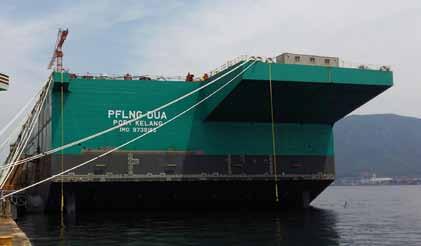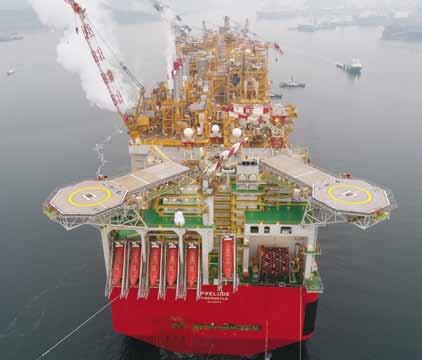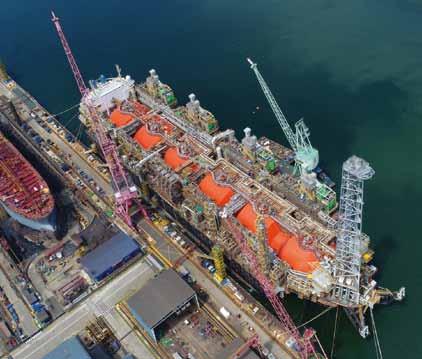
11 minute read
Landmark first export cargo for floating LNG
from IGU Magazine October 2017
by IGU
By Mark Blacklock
v The LNG carrier Seri
Camellia takes on the first cargo from Petronas FLNG Satu.
Years of research and development into the marinisation of liquefaction technology bore fruit on April 1, when the first LNG cargo from an offshore floating production facility was shipped to market. The pioneering projects are set to be joined by a number of others, although the floating sector is not going to expand as rapidly as once thought due to the current low gas prices and glut of conventional capacity.
There are two main types of floating liquefaction projects: those designed to monetise otherwise stranded offshore gas resources and those, typically nearshore projects, where building a liquefaction plant in the controlled environment of a shipyard and towing it to site is a cost-effective alternative to building an onshore facility. In each case the flexibility of being able to relocate the plant is an added benefit.
While Shell’s Prelude was the first floating liquefaction project to be launched – FID was reached in May 2011 – the honours for the first operational project go to Petronas whose FLNG Satu got the go-ahead in March 2012 as part of the company’s efforts to unlock gas resources in Malaysia’s remote and stranded fields.
Petronas FLNG Satu is moored 79m above the Kanowit gas field, 180 kilometres offshore Bintulu, Sarawak. The vessel, 365m long by 60m wide, has a production capacity of 1.2 mtpa and storage for 177,000m ³ of LNG. Classified by DNV GL, it was built by a consortium of Daewoo Shipbuilding and Marine Engineering (DSME) and Technip (now TechnipFMC) and uses the Air Products AP-NTM process
and equipment. The vessel arrived at the field at the end of May 2016 and first gas was reported that November with the first export cargo being shipped to Korea on the LNG carrier Seri Camellia on April 1.
While building up operational experience with FLNG Satu, Petronas is working on a second project, although the timescale for start-up has been pushed back from 2018 to 2020. FLNG Dua is a slightly larger vessel, 381m long by 64m wide, with a production capacity of 1.5 mtpa using the AP-NTM process and storage capacity of 177,000m ³ . Classified by the American Bureau of Shipping (ABS), it is being built by a consortium of Samsung Heavy Industries (SHI) and JGC Corporation and is destined for the Rotan field, 240 kilometres offshore Kota Kinabalu, Sabah. Rotan is a deepwater field with depths of up to 1140m. Whereas Kanowit is operated by Petronas, Rotan is operated by Murphy Oil with Petronas holding a 20% stake.
Both vessels are designed for 20 years of service before dry-docking and have SOFEC external turret mooring systems.
Prelude commissioning underway
Prelude FLNG is a much larger project with a total liquids production of 5.3 mtpa (3.6 LNG using Shell’s dual-mixed refrigerant process, 1.3 condensate and 0.4 LPG) and storage for 220,000m ³ of LNG, 126,000m ³ of condensate and 90,000m ³ of LPG. INPEX (17.5%), KOGAS (10%) and CPC (5%) joined Shell as partners in 2012.
Classified by Lloyd’s Register, Prelude is the world’s largest floating structure, 488m long by 74m wide, and was built by a consortium of SHI and Technip (now TechnipFMC) to develop the Prelude and Concerto fields 200km offshore north-western Australia in the Browse Basin at water depths of 250m. It has been designed to withstand category 5 cyclones (although production will be suspended during harsh weather conditions) and to operate for 25 years

before dry-docking. The internal turret mooring system was designed by SBM Offshore and three Rolls-Royce thrusters ensure the vessel can keep its heading against the wind, current and waves to allow safe tanker berthing.
Prelude was handed over in late June and towed to its location. Commissioning is underway and the first commercial cargo is expected in 2018. But Shell’s plans for further FLNGs have been put on hold for the time being.

z Petronas FLNG Dua is under construction at the SHI yard in Geoje, Korea.
x Prelude being towed
out of the SHI yard en-route to Australia.


z The Hilli Episeyo at the
Keppel yard in Singapore shortly before departure for Cameroon.

Tolling
Two shipping companies, Golar and Exmar have been working on a tolling model for floating liquefaction with Golar converting LNG tankers to DNV GL classification and Exmar commissioning a purpose-built barge to Bureau Veritas classification. Both companies are using Black & Veatch Prico single mixed refrigerant technology.
Exmar’s Caribbean FLNG, 144m long by 32m wide with a capacity of 0.5 mtpa and storage of 16,100m ³ , was built by Wison Offshore & Marine in Nantong, China. It was originally destined for use by Pacific Exploration & Production (formerly Pacific Rubiales) in Colombia, where it would have been moored to a jetty off Tolú on the country’s Caribbean coast to process gas brought by pipeline from the onshore La Creciente field. However, changing market conditions made the project unviable and it was cancelled in March 2016. Construction of the barge was well underway so it continued and was handed over in July but an order for a second barge was cancelled. Exmar is now looking for a customer for Caribbean FLNG.
Golar has lined up three of its LNG carriers for conversion at the Keppel shipyard in Singapore by adding sponson structures to the sides as integral structural sections providing space and deck area for process and utility systems. Each vessel will have a production capacity of 2.4 mtpa using four trains and a storage capacity of 125,000m ³ or 126,000m ³ . They are suitable for sites with benign sea conditions and can be completed in about half the time of a new-build.
The first conversion was of the Golar Hilli (now renamed Hilli Episeyo) for the Cameroon FLNG project. Société Nationale des Hydrocarbures du Cameroun (SNH) and Perenco are the upstream partners developing the Sanaga Sud and Ebome fields, 10km offshore Kribi. Keppel (10%) and Black & Veatch (1%) are partners with Golar (89%) in ownership of the Hilli Episeyo. Production is due to start by the end of 2017 under an eight-year contract and will use two of the vessel’s four trains for an output of 1.2 mtpa. Gazprom Marketing & Trading will be the sole off-taker.
Subject to FID, expected by the end of the year, the second conversion will be of the Golar Gandria for the Fortuna FLNG project offshore Equatorial Guinea. The Fortuna complex is in Block R, some 100km southwest of Bioko Island, in water depths up to 1,900m. Ophir Energy holds an 80% interest in Block R and GE Petrol 20%. A joint operating company of OneLNG – a joint venture of Golar and Schlumberger – (66.2%) and Ophir (33.8%) will develop, finance and operate the Fortuna project, owning Ophir’s share of the Block R licence and the Golar Gandria. First gas is targeted for 2020 and initial output will be 2.2 mtpa with Gunvor Group as the sole offtaker. Further development is proposed to double output which would see a second vessel in service by 2025.
The third candidate for conversion is the Golar Gimi and a customer is being sought. Golar is also working on longer-term tolling
projects with new-build vessels suitable for harsher weather conditions (see below).
African build-up
Mozambique is the latest country to opt for FLNG with FID for the first phase of the Coral South project being reached in June. The Coral discovery lies in the Rovuma Basin (Area 4) some 50km offshore near the border with Tanzania in depths of up to 2,000m.
Eni is the operator of Area 4 with a 50% indirect interest owned through Eni East Africa (EEA), which holds a 70% stake in Area 4. CNPC owns a 20% indirect interest in Area 4 through EEA. The other concessionaires are Galp Energia (10%), KOGAS (10%) and Empresa Nacional de Hidrocarbonetos (10%). In March, Eni signed an agreement to sell 50% of its shares in EEA to ExxonMobil, which is subject to regulatory clearance.
The project involves the construction of six subsea wells connected to an FLNG vessel to be built by a consortium of TechnipFMC, JGC and SHI. SOFEC will supply the turret mooring system. The vessel will be 439m long by 65m wide with a capacity of 3 mtpa of LNG and 0.48 mtpa of condensate. First gas is expected in 2022 and the entire production will be sold to BP under a 20-year contract.
Meanwhile, three other FLNG projects are nearing FID in Mauretania and Senegal (a joint one), Congo-Brazzaville and Cameroon (a second one in addition to Cameroon FLNG).
Tortue FLNG is being developed by BP and Kosmos Energy in partnership with the NOCs of Mauritania and Senegal to exploit gas resources in the Greater Tortue area in depths of up to 2,700m. The working interests in Mauritania are BP 62%, Kosmos 28% and Société Mauritanienne des Hydrocarbures et du Patrimoine Minier 10%, while in Senegal they are BP 60%, Kosmos 30% and Petrosen 10%.
The plan is for an FPSO unit above the field and a 140km pipeline to bring the gas to two FLNG vessels, anchored behind a breakwater 8km offshore on the maritime boundary between Mauritania and Senegal. Each vessel would have a capacity of 2.3 mtpa with startup for the first projected in 2021/2 followed by the second in 2023/4.
The Congo-Brazzaville project involves the Nkala field in Marine XII block 20km offshore in a water depth of 38m, which is operated by Eni with a 65% share. Its partners are New African Global Energy (New Age) with 25% and Société Nationale des Pétroles du Congo with 10%. New Age is driving the midstream development

x FID for Coral South
FLNG was announced at a ceremony in Maputo on June 1.
z Exmar is looking for a
new project to deploy its Caribbean FLNG barge.

proposal for a vessel with a capacity of 1.1 mtpa of LNG and 0.15 mtpa of LPG. The vessel would be built by a consortium of SBM, JGC, China State Shipbuilding Corporation’s Hudong-Zhonghua subsidiary (responsible for the hull) and China Offshore Oil Engineering Company’s Qingdao yard (responsible for the topsides modules). It would be owned by SBM and leased to the project company with startup projected in 2022.
The Cameroon project involves the Etinde field offshore Limbe, which New Age operates with a 30% share in partnership with Lukoil (30%), SNH (20%) and Bowleven subsidiary Euroil (20%). A similar vessel to that proposed for the Congo-Brazzaville project is envisaged with start-up projected in 2023. New Age is seeking partners to invest in its LNG subsidiary and the individual project companies and has a longer-term proposal for the Aje field in Nigeria.
US projects
Amongst the flurry of US LNG export projects based on abundant shale gas resources and a tolling model, one FLNG project has been permitted and a second is in the permitting phase.
Delfin LNG involves up to four FLNG vessels moored in a deepwater port 80km off the coast of Cameron Parish, Louisiana, linked by an existing gas pipeline to a new onshore compression plant. The pipeline was originally built to transport gas from offshore wells in the Gulf of Mexico into the US grid, and the compression plant will allow the flow of the pipeline to be reversed to supply processed gas to the port. Each vessel will have a capacity of 3.25 mtpa and would move to protected waters in the event of a hurricane.
The project is being developed by Delfin Midstream and Golar, who claim it will have the lowest liquefaction costs in North America. Delfin has completed the permitting process with the US Department of Energy, Maritime Administration and Coast Guard and received non-FTA export authorisation in June. FID for the first phase is expected in 2018 with start-up in 2021/2.
The Main Pass Energy Hub 26km offshore Louisiana was originally planned and permitted as an LNG import terminal before the impact of the US shale gas boom was felt. The import project was dropped and the project site and associated assets subsequently acquired by Global LNG Services (GLS) which is planning two FLNG vessels using its proprietary LiquiMax process. Pre-processing of the gas would be carried out on offshore platform structures with the gas then supplied to the vessels for liquefaction. Each vessel would be 390m long by 64m wide with a capacity of 12 mtpa and storage for 300,000m ³ . They would be built by Sembcorp Marine in Singapore with Siemens responsible for the topside modules. FID is scheduled for early 2019 with start-up in 2023.
IGU’s World LNG Report shows there are many more FLNG projects proposed and all eyes will be on the ones that have got the go-ahead to see how their economics work out in practice.
Mark Blacklock is Editor-in-Chief of International Systems and Communications.










